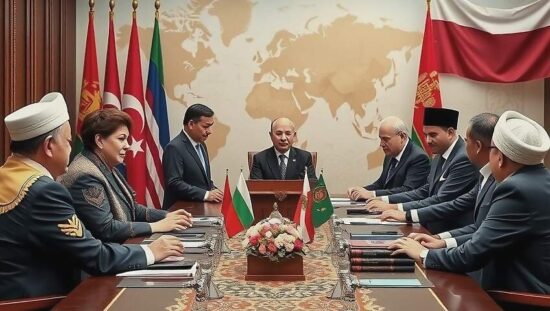The relationships in Central Asia are an important subject for the study of the changes taking place in today’s international relations. The conditions in the region favor not only the main antagonists of the world system – the United States, the Russian Federation and the People’s Republic of China – but also the diverse influence of other extra-regional states. However, it is difficult to look beyond the foreign policy shadows of Beijing, Moscow and Washington. Let alone the fact that this “beyond” can be divided into understandable individual phenomena and processes.
What is significant in the international relations of Kazakhstan, Kyrgyzstan, Tajikistan, Turkmenistan and Uzbekistan, aside from the traditionally important relations with Russia, China and the countries of the Western collective under the leadership of the United States? What are the “lesser” foreign policy priorities of the Central Asian countries?
Some examples from the international life of the Central Asian region clearly show that the modern notions of leadership in international relations is a very relative category that must be considered on a case-by-case basis, taking into account time, place and conditions.
Turkish Initiative
The first regional power in Central Asia, which is somewhat visible, is Turkey. When it comes to classical economic relations in the areas of trade and investment, Ankara is a “mass” actor. Economic statistics from the last ten years show that Turkey accounts for about six percent of Central Asia’s external trade and about 0.5 percent of total foreign investment.
However, the position of Turkey in the field of international labor migration, especially in relations with Kazakhstan, has recently significantly increased. For example, only 4.25 percent of international remittances from individuals were directed to Ankara in 2018, while this figure reached 13.25 percent in 2023, already comparable to the traditionally leading position of the Russian Federation (29 percent).
The political activity of Turkish diplomacy in the region can be traced more clearly and competitively. Turkey is the third country, after the Russian Federation and China, that has begun to build multilateral institutional relations with the countries of the region in the format of the Organization of Turkic States: with international bureaucracy, annual summits and agreements. Other extra-regional actors have not yet gone beyond the multilateral forum diplomacy in the framework of the C5+1 format.
It is worth noting that Ankara also works with a political future vision and offers the countries of the region the “Concept of the Turk World until 2040.” Thus, the Turkish side grounds its own logic of interstate relations at the doctrine level. In this context, Ankara stands at the top of social-political processes comparable to Russia’s “Great Eurasia” or China’s “Shared Fate of Humanity.”
Finally, one of the key elements in the Central Asian vector of Turkish foreign policy is its ability to position itself in the information space of the region. If we measure the number of references in Central Asian media for 2023 to different institutions – USAID, Turksoy, Confucius Institute and Rossotrudnitschestvo – the following results are obtained: the absolute leader is, as expected, the US agency – 1,620 publications with a reach of over 30 million people. However, the second place goes to the International Organization for Turkish Culture (Turksoy) with 747 publications and a reach of over 17 million people, far ahead of Moscow (175 and 4.7 million people) and Beijing (123 and 1.6 million people).
Japanese Money
The second “lesser” partner of the Central Asian states is the Land of the Rising Sun. Due to the geographical distance and the closedness of the domestic labor market, one cannot speak of significant claims in trade, labor and logistics relations with Central Asia. However, the spatial distance has no impact on capital relations. Japan is one of the largest investors in the economy of the region, especially Kazakhstan, with almost four percent of all foreign capital investment, which is comparable to China’s five percent or Russia’s three percent share.
Although Tokyo is not very visible in the architecture of political relations in Central Asia, it was Japan that made pioneering work in multilateral regional diplomacy within the framework of the C5+1 format. This mechanism was much later copied by other extra-regional actors. The first “Central Asia-plus-Japan Dialogue” took place in 2004, but Japan has consciously not deepened its political engagement with the Central Asian countries.
Instead of creating inter-state ad hoc institutions and bureaucracies that are involved in the development of political relations between Japan and Central Asia, Tokyo acts differently and puts Japanese trade and industrial conglomerates at the top, which determine the agenda for relations with the governments in the region. When the Japanese Ministry of Foreign Affairs is the head, the Japanese Association ROTOBO is the neck of Japan’s foreign policy in Central Asia.
Korean Universities
A third example of non-trivial partnerships for Central Asian states is the Republic of Korea. For a long time, Seoul has been on the periphery of the “Great Game.” However, in the last ten years, South Korea has managed to become an important partner for the countries of the region.
In some areas, Seoul has managed to achieve extremely dynamic development speed in interstate relations. If the average annual trade turnover with Central Asia in the period from 2013 to 2017 was 1.8 billion US dollars, then this figure increased to 4.2 billion US dollars in the following five years, which corresponds to a growth of 226 percent! A low base, which, however, allowed the Republic of Korea to take a comparable place among the trade partners of the region in 2023 with a turnover of 6.8 billion US dollars, alongside countries like the United States (6 billion US dollars), France (5.3 billion US dollars), Japan (5.3 billion US dollars) and India (3.7 billion US dollars).
In addition to its trade successes, Seoul manages to realize one of the most attractive models of student mobility. In the last ten years – when comparing five-year periods – the number of Central Asian students in the Republic of Korea has increased by 503 percent. In absolute numbers, this is more than 9,500 students from Central Asia, which in 2022 meant the fifth place after the Russian Federation (165,900), the People’s Republic of China (33,200), Turkey (25,900) and the EU (20,100).
Conclusion
The most important actors – Russia, China and the Western collective – still maintain the most influential relations with the countries in the region. The uncertainty and the prospect of further escalation of relations between the great powers leads to polarization of foreign policy decisions and thus to





